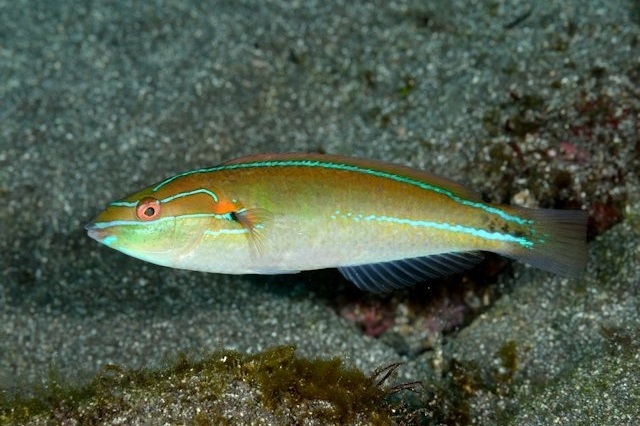Stethojulis interrupta


| Latin name | Stethojulis interrupta - (Bleeker, 1851) |
|---|---|
| Local name | Cutribbon wrasse |
| Family | Labridae - Stethojulis |
| Origin | East Indian Ocean, West Indian Ocean, Australia, Japan, The Red Sea, Indonesia, Central/West Pacific |
| Max length | 13 cm (5.1") |
| Minimum volume |
1000 l (264 gal) |
|---|---|
| Hardiness |
Average |
| Suitable for aquarium |
Experience, preparation and extra care required |
| Reef safe |
Always reef safe |
| Aggressiveness | Mostly peaceful but might be aggressive towards similar species |
| Recommended |
Small crustaceans (Krill, mysis, artemia...) Zooplankton (Cyclops, pods...) |
|---|
This species is known to jump out of open aquaria.
This species requires a constant supply of food in the water.
This species must be fed with an appropriately varied diet.
This species is very sensitive during transportation and acclimatizing into the aquarium.
This species needs a minimum of 2 inch (5 cm) of sand in the aquarium bottom, so it can dig itself down when afraid or needing to sleep.
This species thrives best when there is a sufficiently large amount of micro life (copepods, amphipods or similar) in the aquarium, so that the it can always find their own food.
They can live as a pair provided they are introduced simultaneously.
This species needs good hiding places, for example, between live rocks.
This species revels in swimming and requires an aquarium with ample space.
This species is very shy and docile, so one should be careful when keeping it with more aggressive fish.
This species can change gender from female to male.
When a male is needed, a female changes sex and takes on the role.
Stethojulis are very beautiful when in full colour, but when young their colouring is more matte. Most require almost constant feeding if they are to survive in an aquarium for any length of time. Their frequent feeding is required because of their constant activity, this also means they must be provided with ample space for swimming.
When one has an very large tank with plenty of zooplankton and hiding places, then the chances of success are good. Without available natural food it is essential to have an automatic feeders to provide regular, daily food of a varied nature.
These fish eat most of types of frozen foods like, i.e. Mysis, Artemia and cyclops. They can be a threat to small invertebrates like snails and shrimps.
They must not be kept with aggressive fish, as this will make their acclimatization problematic.
When feeling threatened or needing sleep, they dig themselves into the sand.
Wrasses are nearly always seen in reef aquaria, since many of the species are both attractive and useful in battling a range of unwanted invertebrates like i.e. flatworms, pyramide snails.
These fish live of everything from zooplankton to large crustaceans, sea urchins and the like.
The needs and behaviour of Wrasses vary greatly, so it is vital to familiarize oneself with the specific species before buying one.
| Aquarium trade | Yes |
|---|---|
| Distribution | Indo-West Pacific: Red Sea and East Africa to Papua New Guinea, south to Lord Howe Island. Unknown from Micronesia. |
| English common names |
Wrasse Cut-ribbon wrasse Cutribbon wrasse One-line rainbowfish Brokeline wrasse |
Bob Fenner. The Spastic Wrasses of the Genus Stethojulis - Wet Web Media - (English)
Scott W. Michael. 2009. Wrasses and Parrotfishes (Reef Fishes Series Book 5) - TFH Publications / Microcosm Ltd. - (English)

